Individual Research Report on Agile Project Management (MIS608)
VerifiedAdded on 2022/11/24
|8
|1967
|403
Report
AI Summary
This research report provides a comprehensive overview of Agile project management, addressing its origins, the Agile Manifesto, and its emergence as a response to traditional software development methodologies. It explores the influence of Lean principles on Agile practices, highlighting how Lean's focus on waste reduction and continuous improvement has shaped Agile methodologies. The report then delves into a comparative analysis of Scrum and Kanban, two prominent Agile frameworks, outlining their similarities and differences in terms of workflow, roles, and cadence. Finally, the report examines the various benefits of adopting Agile within an organization, including enhanced collaboration, increased flexibility, improved product quality, and faster project delivery. The report uses credible sources to support its findings and concludes with a summary of the key takeaways and implications of Agile project management.
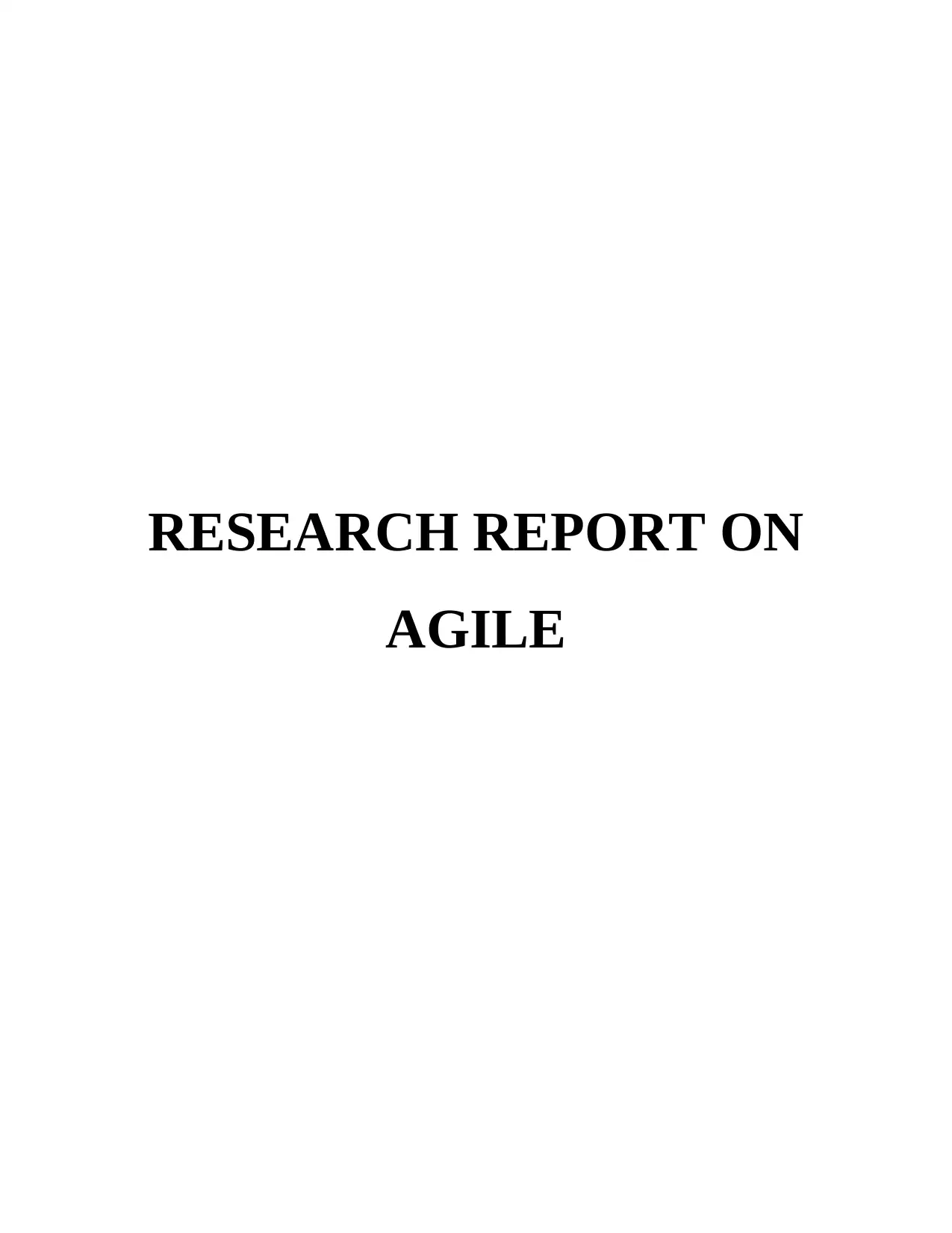
RESEARCH REPORT ON
AGILE
AGILE
Paraphrase This Document
Need a fresh take? Get an instant paraphrase of this document with our AI Paraphraser
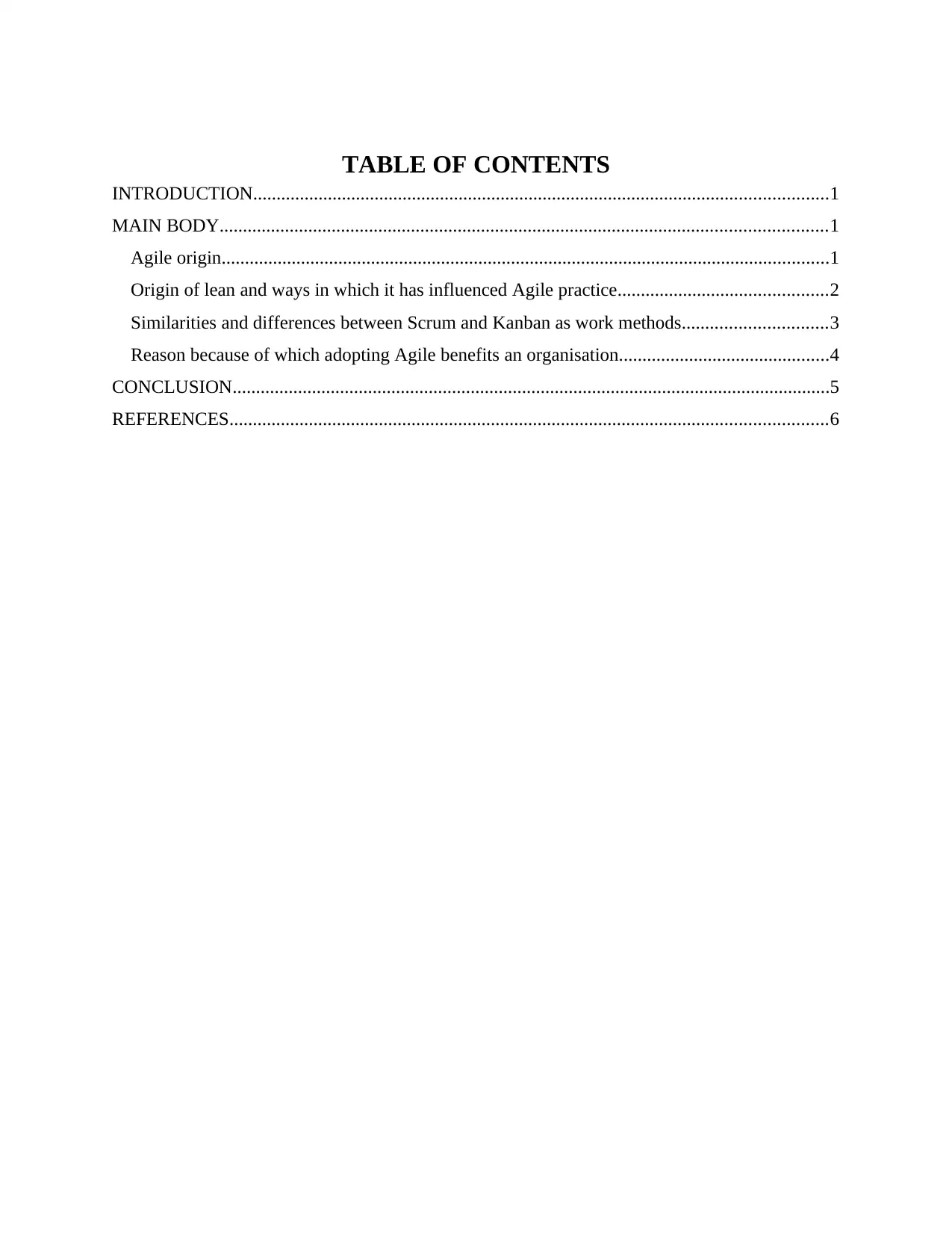
TABLE OF CONTENTS
INTRODUCTION...........................................................................................................................1
MAIN BODY..................................................................................................................................1
Agile origin..................................................................................................................................1
Origin of lean and ways in which it has influenced Agile practice.............................................2
Similarities and differences between Scrum and Kanban as work methods...............................3
Reason because of which adopting Agile benefits an organisation.............................................4
CONCLUSION................................................................................................................................5
REFERENCES................................................................................................................................6
INTRODUCTION...........................................................................................................................1
MAIN BODY..................................................................................................................................1
Agile origin..................................................................................................................................1
Origin of lean and ways in which it has influenced Agile practice.............................................2
Similarities and differences between Scrum and Kanban as work methods...............................3
Reason because of which adopting Agile benefits an organisation.............................................4
CONCLUSION................................................................................................................................5
REFERENCES................................................................................................................................6
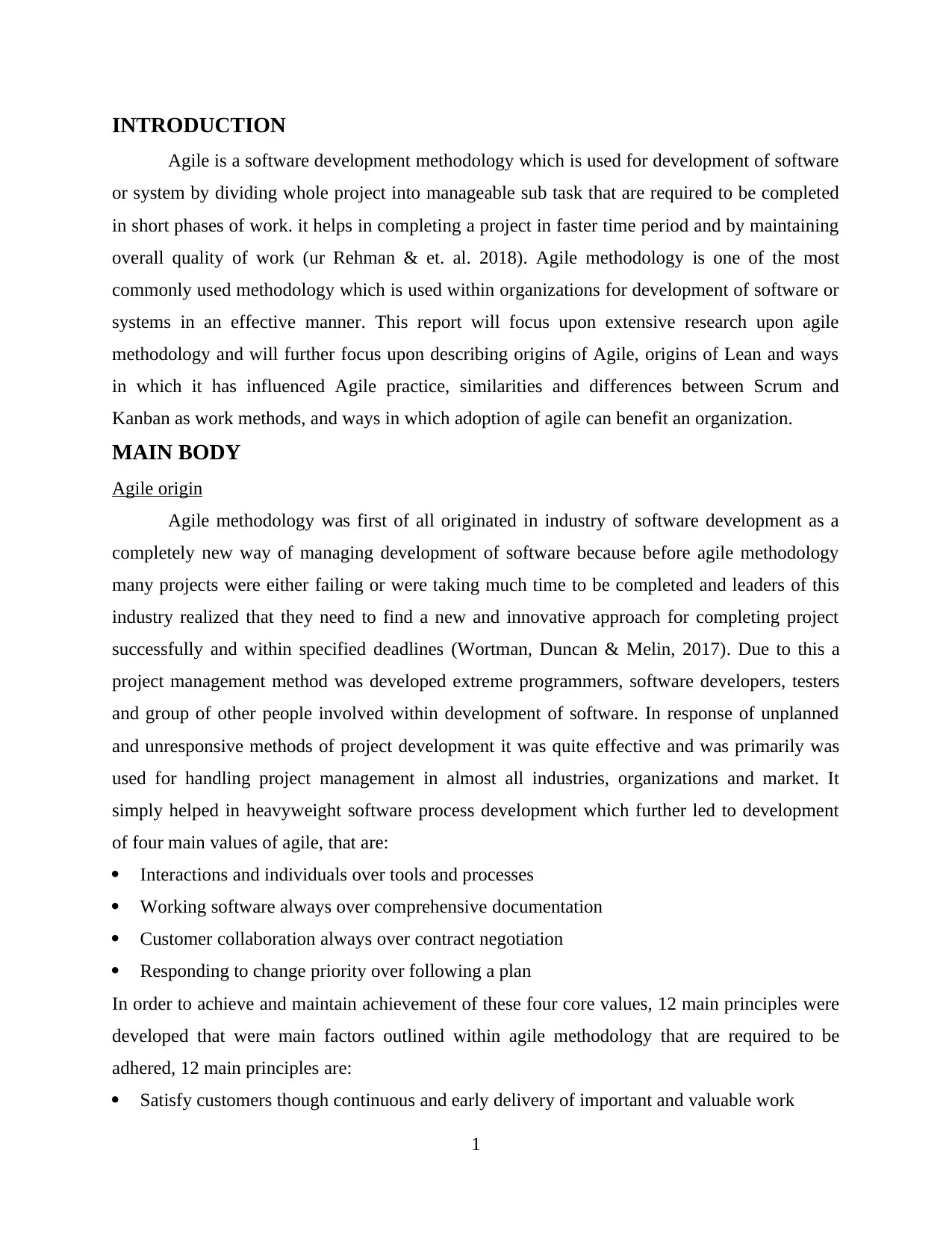
INTRODUCTION
Agile is a software development methodology which is used for development of software
or system by dividing whole project into manageable sub task that are required to be completed
in short phases of work. it helps in completing a project in faster time period and by maintaining
overall quality of work (ur Rehman & et. al. 2018). Agile methodology is one of the most
commonly used methodology which is used within organizations for development of software or
systems in an effective manner. This report will focus upon extensive research upon agile
methodology and will further focus upon describing origins of Agile, origins of Lean and ways
in which it has influenced Agile practice, similarities and differences between Scrum and
Kanban as work methods, and ways in which adoption of agile can benefit an organization.
MAIN BODY
Agile origin
Agile methodology was first of all originated in industry of software development as a
completely new way of managing development of software because before agile methodology
many projects were either failing or were taking much time to be completed and leaders of this
industry realized that they need to find a new and innovative approach for completing project
successfully and within specified deadlines (Wortman, Duncan & Melin, 2017). Due to this a
project management method was developed extreme programmers, software developers, testers
and group of other people involved within development of software. In response of unplanned
and unresponsive methods of project development it was quite effective and was primarily was
used for handling project management in almost all industries, organizations and market. It
simply helped in heavyweight software process development which further led to development
of four main values of agile, that are:
Interactions and individuals over tools and processes
Working software always over comprehensive documentation
Customer collaboration always over contract negotiation
Responding to change priority over following a plan
In order to achieve and maintain achievement of these four core values, 12 main principles were
developed that were main factors outlined within agile methodology that are required to be
adhered, 12 main principles are:
Satisfy customers though continuous and early delivery of important and valuable work
1
Agile is a software development methodology which is used for development of software
or system by dividing whole project into manageable sub task that are required to be completed
in short phases of work. it helps in completing a project in faster time period and by maintaining
overall quality of work (ur Rehman & et. al. 2018). Agile methodology is one of the most
commonly used methodology which is used within organizations for development of software or
systems in an effective manner. This report will focus upon extensive research upon agile
methodology and will further focus upon describing origins of Agile, origins of Lean and ways
in which it has influenced Agile practice, similarities and differences between Scrum and
Kanban as work methods, and ways in which adoption of agile can benefit an organization.
MAIN BODY
Agile origin
Agile methodology was first of all originated in industry of software development as a
completely new way of managing development of software because before agile methodology
many projects were either failing or were taking much time to be completed and leaders of this
industry realized that they need to find a new and innovative approach for completing project
successfully and within specified deadlines (Wortman, Duncan & Melin, 2017). Due to this a
project management method was developed extreme programmers, software developers, testers
and group of other people involved within development of software. In response of unplanned
and unresponsive methods of project development it was quite effective and was primarily was
used for handling project management in almost all industries, organizations and market. It
simply helped in heavyweight software process development which further led to development
of four main values of agile, that are:
Interactions and individuals over tools and processes
Working software always over comprehensive documentation
Customer collaboration always over contract negotiation
Responding to change priority over following a plan
In order to achieve and maintain achievement of these four core values, 12 main principles were
developed that were main factors outlined within agile methodology that are required to be
adhered, 12 main principles are:
Satisfy customers though continuous and early delivery of important and valuable work
1
⊘ This is a preview!⊘
Do you want full access?
Subscribe today to unlock all pages.

Trusted by 1+ million students worldwide
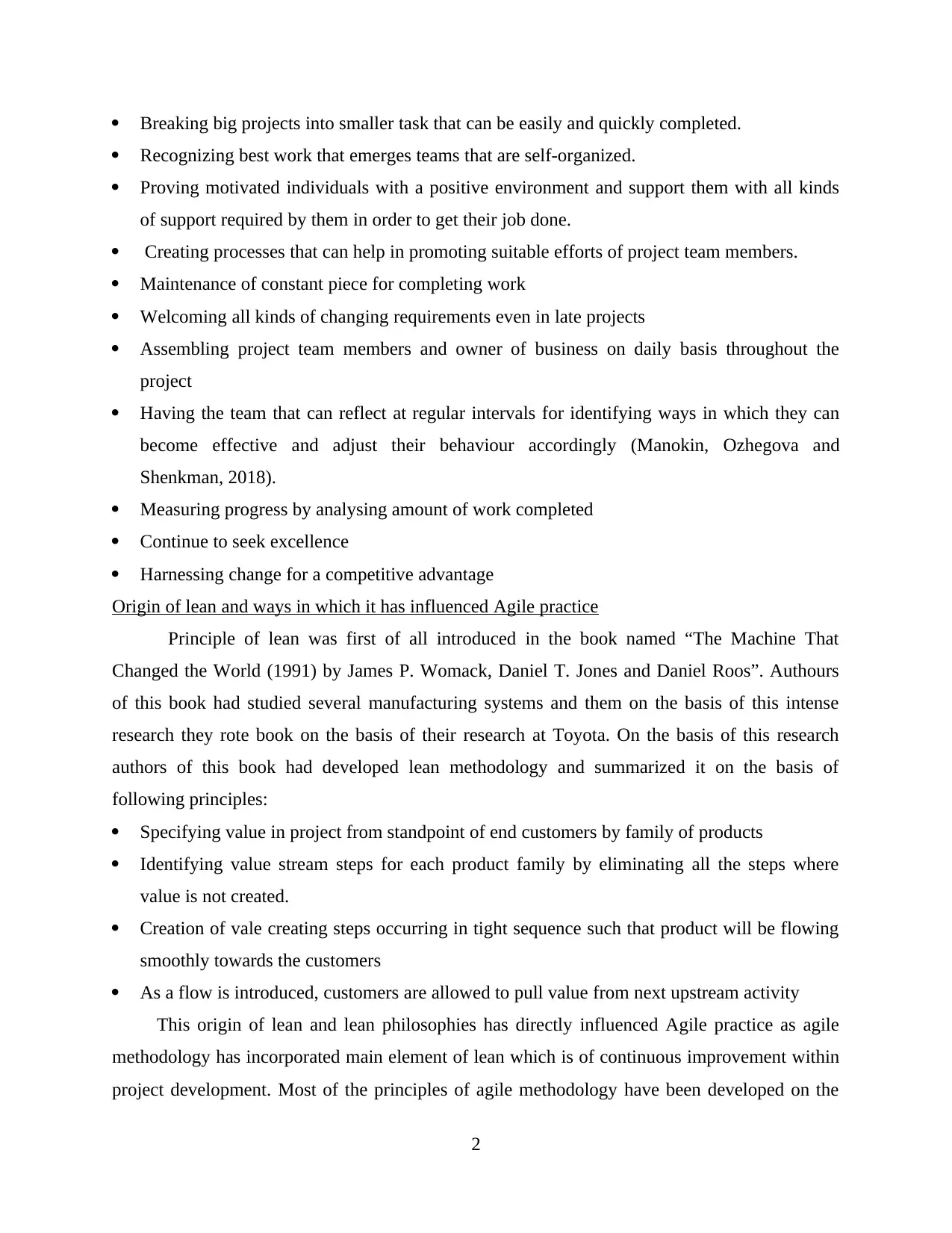
Breaking big projects into smaller task that can be easily and quickly completed.
Recognizing best work that emerges teams that are self-organized.
Proving motivated individuals with a positive environment and support them with all kinds
of support required by them in order to get their job done.
Creating processes that can help in promoting suitable efforts of project team members.
Maintenance of constant piece for completing work
Welcoming all kinds of changing requirements even in late projects
Assembling project team members and owner of business on daily basis throughout the
project
Having the team that can reflect at regular intervals for identifying ways in which they can
become effective and adjust their behaviour accordingly (Manokin, Ozhegova and
Shenkman, 2018).
Measuring progress by analysing amount of work completed
Continue to seek excellence
Harnessing change for a competitive advantage
Origin of lean and ways in which it has influenced Agile practice
Principle of lean was first of all introduced in the book named “The Machine That
Changed the World (1991) by James P. Womack, Daniel T. Jones and Daniel Roos”. Authours
of this book had studied several manufacturing systems and them on the basis of this intense
research they rote book on the basis of their research at Toyota. On the basis of this research
authors of this book had developed lean methodology and summarized it on the basis of
following principles:
Specifying value in project from standpoint of end customers by family of products
Identifying value stream steps for each product family by eliminating all the steps where
value is not created.
Creation of vale creating steps occurring in tight sequence such that product will be flowing
smoothly towards the customers
As a flow is introduced, customers are allowed to pull value from next upstream activity
This origin of lean and lean philosophies has directly influenced Agile practice as agile
methodology has incorporated main element of lean which is of continuous improvement within
project development. Most of the principles of agile methodology have been developed on the
2
Recognizing best work that emerges teams that are self-organized.
Proving motivated individuals with a positive environment and support them with all kinds
of support required by them in order to get their job done.
Creating processes that can help in promoting suitable efforts of project team members.
Maintenance of constant piece for completing work
Welcoming all kinds of changing requirements even in late projects
Assembling project team members and owner of business on daily basis throughout the
project
Having the team that can reflect at regular intervals for identifying ways in which they can
become effective and adjust their behaviour accordingly (Manokin, Ozhegova and
Shenkman, 2018).
Measuring progress by analysing amount of work completed
Continue to seek excellence
Harnessing change for a competitive advantage
Origin of lean and ways in which it has influenced Agile practice
Principle of lean was first of all introduced in the book named “The Machine That
Changed the World (1991) by James P. Womack, Daniel T. Jones and Daniel Roos”. Authours
of this book had studied several manufacturing systems and them on the basis of this intense
research they rote book on the basis of their research at Toyota. On the basis of this research
authors of this book had developed lean methodology and summarized it on the basis of
following principles:
Specifying value in project from standpoint of end customers by family of products
Identifying value stream steps for each product family by eliminating all the steps where
value is not created.
Creation of vale creating steps occurring in tight sequence such that product will be flowing
smoothly towards the customers
As a flow is introduced, customers are allowed to pull value from next upstream activity
This origin of lean and lean philosophies has directly influenced Agile practice as agile
methodology has incorporated main element of lean which is of continuous improvement within
project development. Most of the principles of agile methodology have been developed on the
2
Paraphrase This Document
Need a fresh take? Get an instant paraphrase of this document with our AI Paraphraser
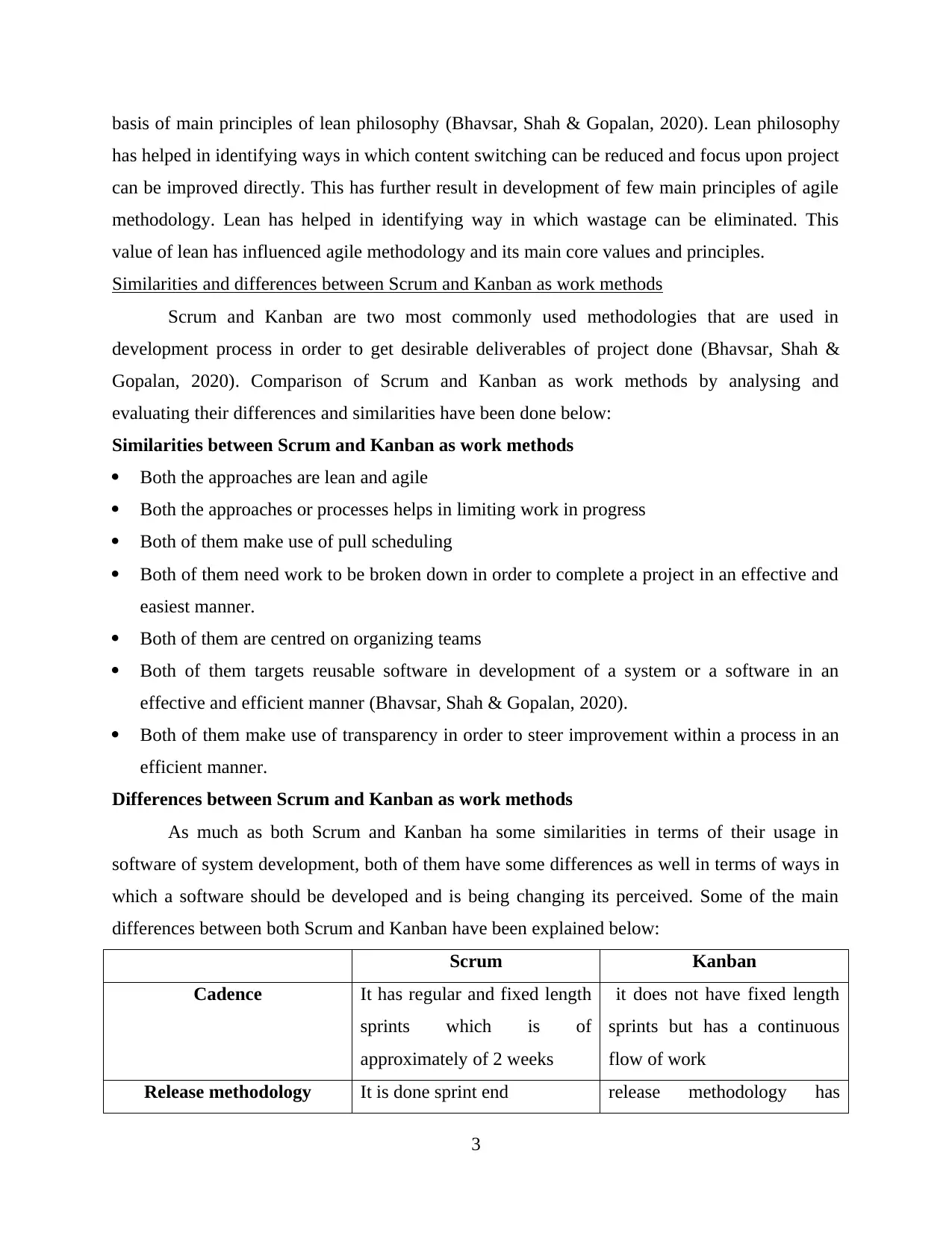
basis of main principles of lean philosophy (Bhavsar, Shah & Gopalan, 2020). Lean philosophy
has helped in identifying ways in which content switching can be reduced and focus upon project
can be improved directly. This has further result in development of few main principles of agile
methodology. Lean has helped in identifying way in which wastage can be eliminated. This
value of lean has influenced agile methodology and its main core values and principles.
Similarities and differences between Scrum and Kanban as work methods
Scrum and Kanban are two most commonly used methodologies that are used in
development process in order to get desirable deliverables of project done (Bhavsar, Shah &
Gopalan, 2020). Comparison of Scrum and Kanban as work methods by analysing and
evaluating their differences and similarities have been done below:
Similarities between Scrum and Kanban as work methods
Both the approaches are lean and agile
Both the approaches or processes helps in limiting work in progress
Both of them make use of pull scheduling
Both of them need work to be broken down in order to complete a project in an effective and
easiest manner.
Both of them are centred on organizing teams
Both of them targets reusable software in development of a system or a software in an
effective and efficient manner (Bhavsar, Shah & Gopalan, 2020).
Both of them make use of transparency in order to steer improvement within a process in an
efficient manner.
Differences between Scrum and Kanban as work methods
As much as both Scrum and Kanban ha some similarities in terms of their usage in
software of system development, both of them have some differences as well in terms of ways in
which a software should be developed and is being changing its perceived. Some of the main
differences between both Scrum and Kanban have been explained below:
Scrum Kanban
Cadence It has regular and fixed length
sprints which is of
approximately of 2 weeks
it does not have fixed length
sprints but has a continuous
flow of work
Release methodology It is done sprint end release methodology has
3
has helped in identifying ways in which content switching can be reduced and focus upon project
can be improved directly. This has further result in development of few main principles of agile
methodology. Lean has helped in identifying way in which wastage can be eliminated. This
value of lean has influenced agile methodology and its main core values and principles.
Similarities and differences between Scrum and Kanban as work methods
Scrum and Kanban are two most commonly used methodologies that are used in
development process in order to get desirable deliverables of project done (Bhavsar, Shah &
Gopalan, 2020). Comparison of Scrum and Kanban as work methods by analysing and
evaluating their differences and similarities have been done below:
Similarities between Scrum and Kanban as work methods
Both the approaches are lean and agile
Both the approaches or processes helps in limiting work in progress
Both of them make use of pull scheduling
Both of them need work to be broken down in order to complete a project in an effective and
easiest manner.
Both of them are centred on organizing teams
Both of them targets reusable software in development of a system or a software in an
effective and efficient manner (Bhavsar, Shah & Gopalan, 2020).
Both of them make use of transparency in order to steer improvement within a process in an
efficient manner.
Differences between Scrum and Kanban as work methods
As much as both Scrum and Kanban ha some similarities in terms of their usage in
software of system development, both of them have some differences as well in terms of ways in
which a software should be developed and is being changing its perceived. Some of the main
differences between both Scrum and Kanban have been explained below:
Scrum Kanban
Cadence It has regular and fixed length
sprints which is of
approximately of 2 weeks
it does not have fixed length
sprints but has a continuous
flow of work
Release methodology It is done sprint end release methodology has
3
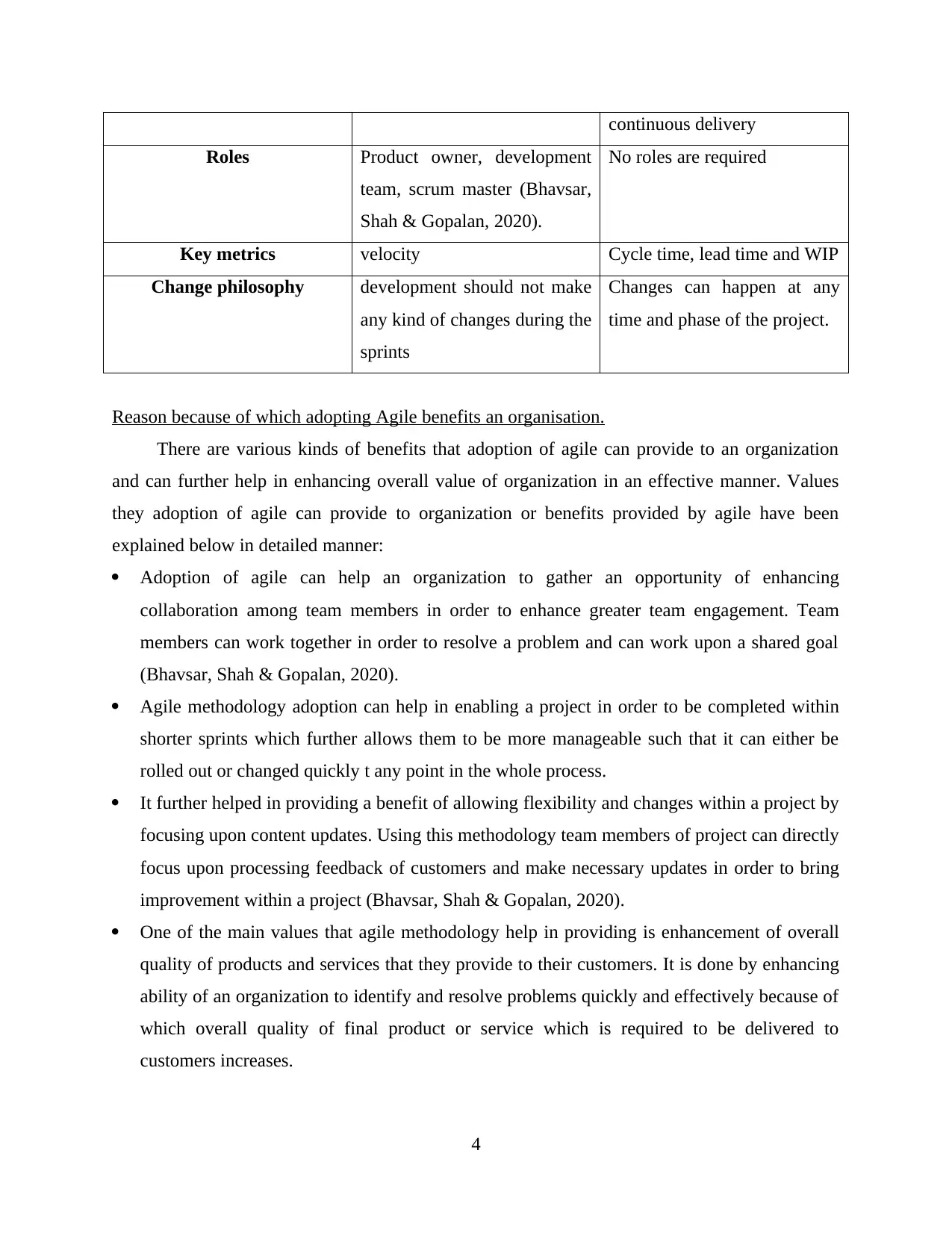
continuous delivery
Roles Product owner, development
team, scrum master (Bhavsar,
Shah & Gopalan, 2020).
No roles are required
Key metrics velocity Cycle time, lead time and WIP
Change philosophy development should not make
any kind of changes during the
sprints
Changes can happen at any
time and phase of the project.
Reason because of which adopting Agile benefits an organisation.
There are various kinds of benefits that adoption of agile can provide to an organization
and can further help in enhancing overall value of organization in an effective manner. Values
they adoption of agile can provide to organization or benefits provided by agile have been
explained below in detailed manner:
Adoption of agile can help an organization to gather an opportunity of enhancing
collaboration among team members in order to enhance greater team engagement. Team
members can work together in order to resolve a problem and can work upon a shared goal
(Bhavsar, Shah & Gopalan, 2020).
Agile methodology adoption can help in enabling a project in order to be completed within
shorter sprints which further allows them to be more manageable such that it can either be
rolled out or changed quickly t any point in the whole process.
It further helped in providing a benefit of allowing flexibility and changes within a project by
focusing upon content updates. Using this methodology team members of project can directly
focus upon processing feedback of customers and make necessary updates in order to bring
improvement within a project (Bhavsar, Shah & Gopalan, 2020).
One of the main values that agile methodology help in providing is enhancement of overall
quality of products and services that they provide to their customers. It is done by enhancing
ability of an organization to identify and resolve problems quickly and effectively because of
which overall quality of final product or service which is required to be delivered to
customers increases.
4
Roles Product owner, development
team, scrum master (Bhavsar,
Shah & Gopalan, 2020).
No roles are required
Key metrics velocity Cycle time, lead time and WIP
Change philosophy development should not make
any kind of changes during the
sprints
Changes can happen at any
time and phase of the project.
Reason because of which adopting Agile benefits an organisation.
There are various kinds of benefits that adoption of agile can provide to an organization
and can further help in enhancing overall value of organization in an effective manner. Values
they adoption of agile can provide to organization or benefits provided by agile have been
explained below in detailed manner:
Adoption of agile can help an organization to gather an opportunity of enhancing
collaboration among team members in order to enhance greater team engagement. Team
members can work together in order to resolve a problem and can work upon a shared goal
(Bhavsar, Shah & Gopalan, 2020).
Agile methodology adoption can help in enabling a project in order to be completed within
shorter sprints which further allows them to be more manageable such that it can either be
rolled out or changed quickly t any point in the whole process.
It further helped in providing a benefit of allowing flexibility and changes within a project by
focusing upon content updates. Using this methodology team members of project can directly
focus upon processing feedback of customers and make necessary updates in order to bring
improvement within a project (Bhavsar, Shah & Gopalan, 2020).
One of the main values that agile methodology help in providing is enhancement of overall
quality of products and services that they provide to their customers. It is done by enhancing
ability of an organization to identify and resolve problems quickly and effectively because of
which overall quality of final product or service which is required to be delivered to
customers increases.
4
⊘ This is a preview!⊘
Do you want full access?
Subscribe today to unlock all pages.

Trusted by 1+ million students worldwide
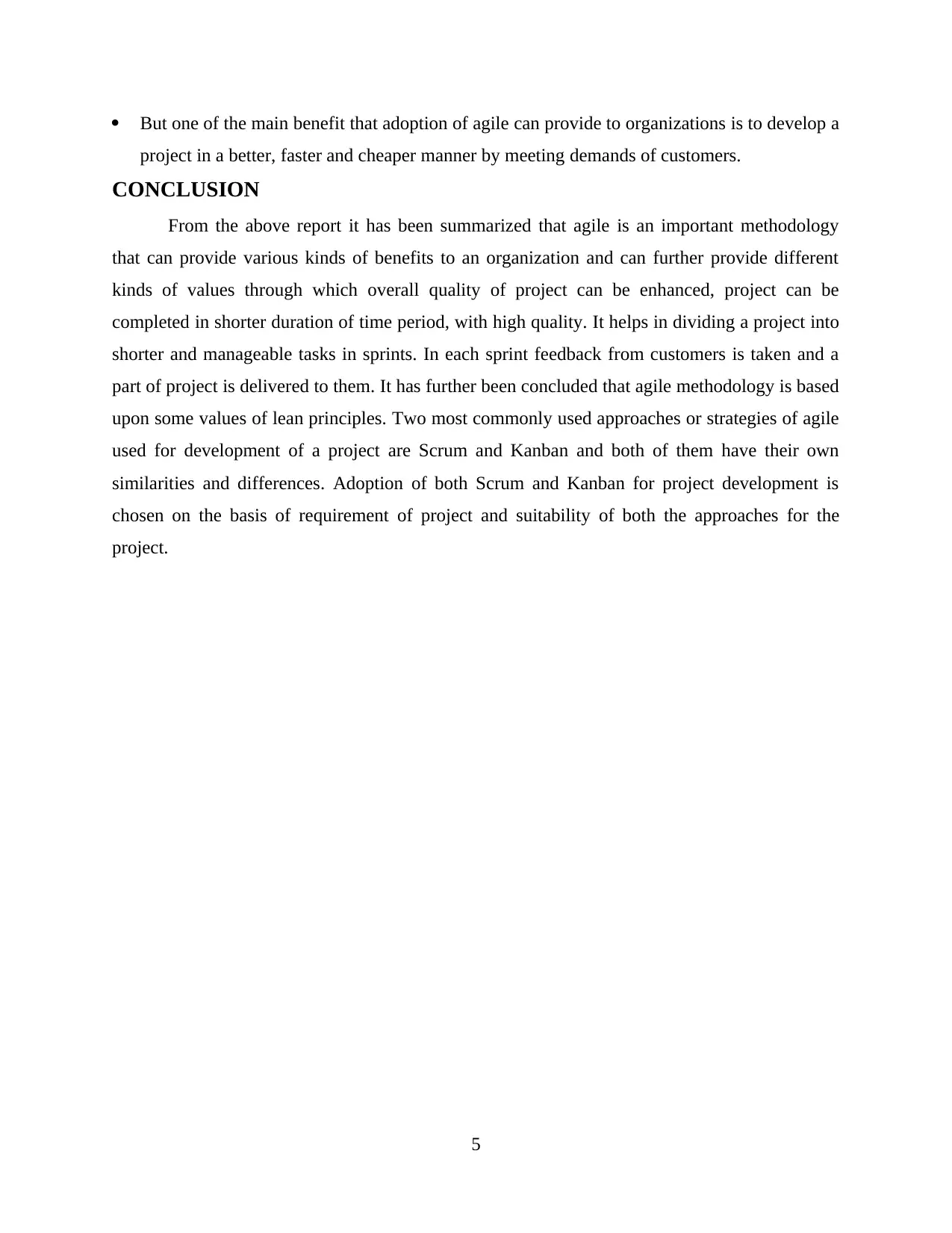
But one of the main benefit that adoption of agile can provide to organizations is to develop a
project in a better, faster and cheaper manner by meeting demands of customers.
CONCLUSION
From the above report it has been summarized that agile is an important methodology
that can provide various kinds of benefits to an organization and can further provide different
kinds of values through which overall quality of project can be enhanced, project can be
completed in shorter duration of time period, with high quality. It helps in dividing a project into
shorter and manageable tasks in sprints. In each sprint feedback from customers is taken and a
part of project is delivered to them. It has further been concluded that agile methodology is based
upon some values of lean principles. Two most commonly used approaches or strategies of agile
used for development of a project are Scrum and Kanban and both of them have their own
similarities and differences. Adoption of both Scrum and Kanban for project development is
chosen on the basis of requirement of project and suitability of both the approaches for the
project.
5
project in a better, faster and cheaper manner by meeting demands of customers.
CONCLUSION
From the above report it has been summarized that agile is an important methodology
that can provide various kinds of benefits to an organization and can further provide different
kinds of values through which overall quality of project can be enhanced, project can be
completed in shorter duration of time period, with high quality. It helps in dividing a project into
shorter and manageable tasks in sprints. In each sprint feedback from customers is taken and a
part of project is delivered to them. It has further been concluded that agile methodology is based
upon some values of lean principles. Two most commonly used approaches or strategies of agile
used for development of a project are Scrum and Kanban and both of them have their own
similarities and differences. Adoption of both Scrum and Kanban for project development is
chosen on the basis of requirement of project and suitability of both the approaches for the
project.
5
Paraphrase This Document
Need a fresh take? Get an instant paraphrase of this document with our AI Paraphraser
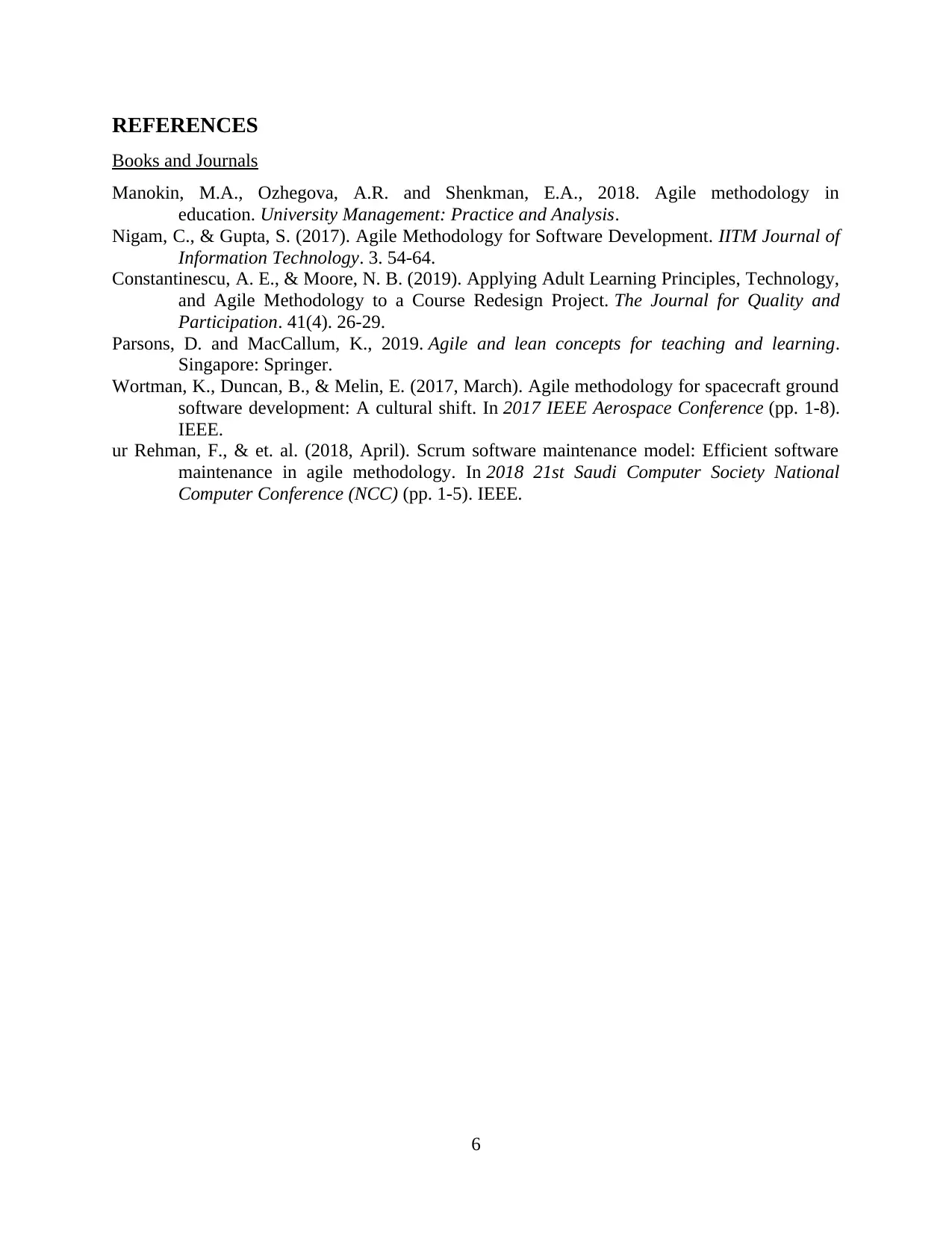
REFERENCES
Books and Journals
Manokin, M.A., Ozhegova, A.R. and Shenkman, E.A., 2018. Agile methodology in
education. University Management: Practice and Analysis.
Nigam, C., & Gupta, S. (2017). Agile Methodology for Software Development. IITM Journal of
Information Technology. 3. 54-64.
Constantinescu, A. E., & Moore, N. B. (2019). Applying Adult Learning Principles, Technology,
and Agile Methodology to a Course Redesign Project. The Journal for Quality and
Participation. 41(4). 26-29.
Parsons, D. and MacCallum, K., 2019. Agile and lean concepts for teaching and learning.
Singapore: Springer.
Wortman, K., Duncan, B., & Melin, E. (2017, March). Agile methodology for spacecraft ground
software development: A cultural shift. In 2017 IEEE Aerospace Conference (pp. 1-8).
IEEE.
ur Rehman, F., & et. al. (2018, April). Scrum software maintenance model: Efficient software
maintenance in agile methodology. In 2018 21st Saudi Computer Society National
Computer Conference (NCC) (pp. 1-5). IEEE.
6
Books and Journals
Manokin, M.A., Ozhegova, A.R. and Shenkman, E.A., 2018. Agile methodology in
education. University Management: Practice and Analysis.
Nigam, C., & Gupta, S. (2017). Agile Methodology for Software Development. IITM Journal of
Information Technology. 3. 54-64.
Constantinescu, A. E., & Moore, N. B. (2019). Applying Adult Learning Principles, Technology,
and Agile Methodology to a Course Redesign Project. The Journal for Quality and
Participation. 41(4). 26-29.
Parsons, D. and MacCallum, K., 2019. Agile and lean concepts for teaching and learning.
Singapore: Springer.
Wortman, K., Duncan, B., & Melin, E. (2017, March). Agile methodology for spacecraft ground
software development: A cultural shift. In 2017 IEEE Aerospace Conference (pp. 1-8).
IEEE.
ur Rehman, F., & et. al. (2018, April). Scrum software maintenance model: Efficient software
maintenance in agile methodology. In 2018 21st Saudi Computer Society National
Computer Conference (NCC) (pp. 1-5). IEEE.
6
1 out of 8
Related Documents
Your All-in-One AI-Powered Toolkit for Academic Success.
+13062052269
info@desklib.com
Available 24*7 on WhatsApp / Email
![[object Object]](/_next/static/media/star-bottom.7253800d.svg)
Unlock your academic potential
Copyright © 2020–2025 A2Z Services. All Rights Reserved. Developed and managed by ZUCOL.


